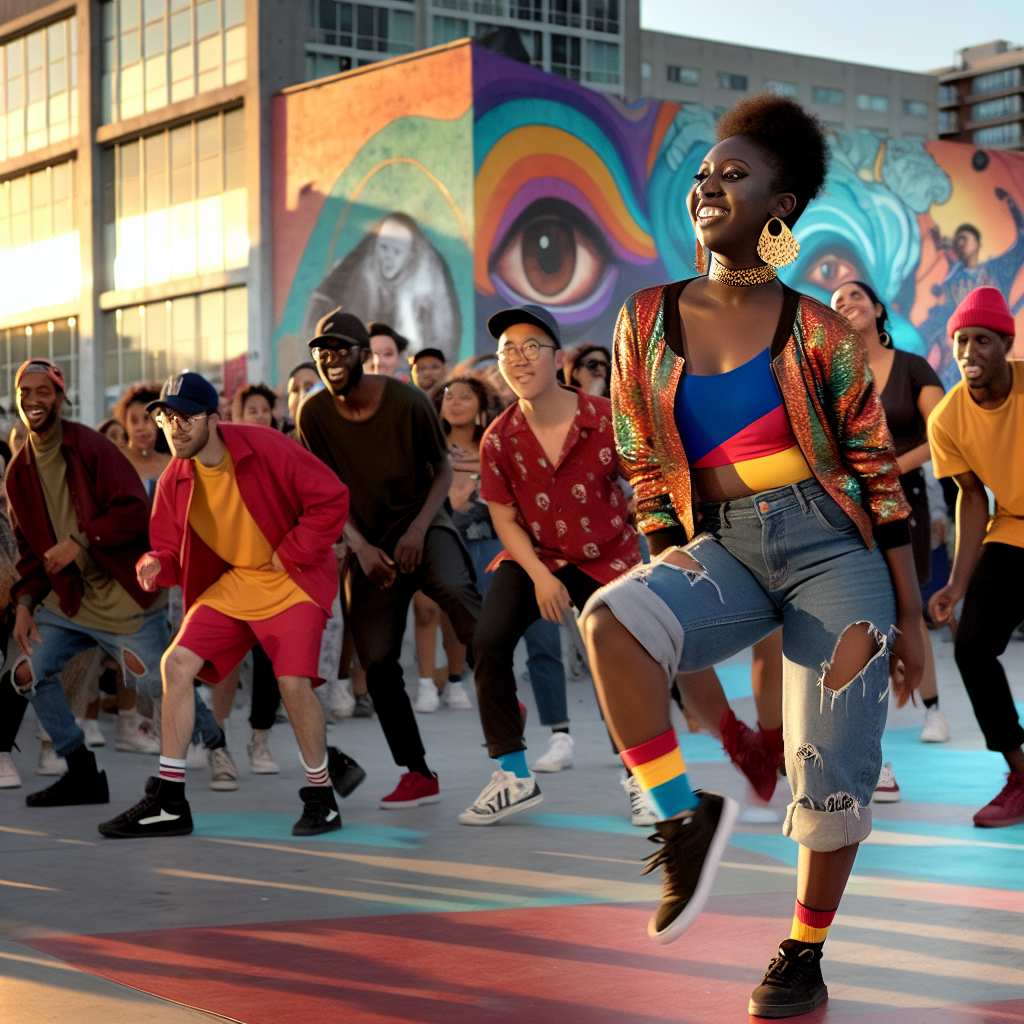
The beat drops, a finger snap, and suddenly millions of people worldwide are performing the exact same choreography. What was once confined to dance studios and professional stages has transformed into a global phenomenon, accessible to anyone with a smartphone and a TikTok account. This digital revolution in dance represents one of the most fascinating cultural developments of our time, blurring geographical boundaries and democratizing an art form that has historically been limited by access and privilege.
The Dance Democracy
TikTok has fundamentally altered how dance moves spread across the globe. Before the app’s meteoric rise, dance trends typically followed a top-down trajectory choreographers created, professionals performed, and the public consumed. Today, a teenager in suburban America can create a 15-second dance that might be performed by millions in Indonesia by the following weekend.
I’ve watched this phenomenon unfold with a mixture of fascination and awe. The platform’s algorithm doesn’t discriminate based on follower counts or previous success it simply promotes content that engages viewers. This has created what I call a “dance democracy,” where viral success depends more on creativity and timing than on established reputation or technical training.
Take the case of Jalaiah Harmon, who created the wildly popular “Renegade” dance in 2019. Despite initially not receiving credit for her creation, the dance spread like wildfire across TikTok, eventually being performed by celebrities and influencers worldwide. What’s remarkable isn’t just the dance’s popularity but how it ultimately led to proper recognition for its 14-year-old creator, highlighting TikTok’s capacity to both obscure and eventually celebrate authentic artistic origins.
Cultural Fusion in Digital Spaces
What truly sets TikTok apart from previous social media platforms is its ability to facilitate unprecedented levels of cultural exchange. Dance styles that were once regionally specific now blend seamlessly in the digital realm, creating hybrid forms that would have been unimaginable a decade ago.
Traditional dances from West Africa merge with K-pop-inspired choreography. Indian classical movements intertwine with contemporary street styles. According to me, this cross-pollination represents more than mere entertainment it’s a visual representation of cultural globalization happening in real-time, documented and distributed through millions of short videos.
Last summer, I found myself at a wedding where the DJ played a song that had gone viral on TikTok. Within seconds, guests spanning three generations formed lines and performed the associated dance moves in perfect unison. The oldest participant was the grandmother of the bride, in her seventies, who had learned the choreography from her grandchildren. In that moment, I witnessed how TikTok had not only crossed geographical boundaries but generational ones as well.
The Acceleration of Trend Cycles
The speed at which dance trends emerge, peak, and fade on TikTok has compressed what once took months or years into days or weeks. This acceleration has profound implications for how we understand cultural evolution in the digital age.
Before social media, dance trends might take years to travel globally. The Macarena, one of the most famous pre-internet dance crazes, took nearly two years to reach peak global popularity in the mid-1990s. Today, a dance might reach worldwide saturation within 72 hours.
This compression creates a fascinating paradox: while more people than ever participate in these shared cultural moments, their ephemeral nature means many trends disappear before they can develop deeper cultural significance. In my opinion, this represents both the beauty and limitation of TikTok-driven dance phenomena they unite us momentarily but often lack the staying power of slower-evolving cultural movements.
Democratization and Accessibility
Perhaps the most revolutionary aspect of TikTok’s influence on dance culture is its democratization of participation. Traditional dance education has historically been constrained by economic and geographical barriers access to studios, qualified teachers, and performance opportunities required resources not available to many.
TikTok has shattered these barriers. Anyone with a smartphone can learn, practice, and share dance moves, regardless of formal training or financial means. This accessibility has created opportunities for dancers from marginalized communities to showcase their talents and cultural traditions to global audiences.
A particularly inspiring example comes from Indigenous TikTok creators who use the platform to preserve and share traditional dances with both their communities and the wider world. These creators have found in TikTok a powerful tool for cultural preservation and education, transforming what might have been seen as just another social media platform into a vessel for meaningful cultural transmission.
The Commercialization Conundrum
As with any cultural phenomenon that attracts millions of eyeballs, TikTok’s dance ecosystem has rapidly commercialized. Brands partner with popular creators, songs are engineered specifically to inspire viral choreography, and the platform itself has become a crucial marketing channel for the music industry.
This commercialization creates complex dynamics. On one hand, it provides financial opportunities for talented dancers who might otherwise struggle to monetize their skills. On the other, it risks homogenizing dance content as creators chase trends and brand deals rather than authentic expression.
The story of the “Savage” dance, which helped propel Megan Thee Stallion’s song to massive success, illustrates this duality. The dance, created by Keara Wilson, generated millions of dollars in value for the music industry while initially yielding little financial benefit for Wilson herself. Only after significant public pressure did recognition and compensation begin to flow to the original creator.
Cultural Appropriation in Hyperspeed
The rapid spread of dance moves on TikTok has intensified long-standing concerns about cultural appropriation. When choreography rooted in specific cultural traditions goes viral, it often becomes detached from its origins and context, raising questions about respect, attribution, and exploitation.
In 2021, a controversy erupted when several white TikTok creators performed dances created by Black choreographers on The Tonight Show without crediting the original creators. The incident sparked important conversations about racial equity in digital spaces and the responsibility of platforms and users to acknowledge the sources of cultural content.
What makes this issue particularly challenging on TikTok is the platform’s design, which doesn’t inherently facilitate attribution. Unlike Twitter’s retweet or Instagram’s repost functions, TikTok’s duet feature, while powerful for collaboration, doesn’t automatically credit original creators.
Physical Impact and Dance Education
Beyond cultural implications, TikTok has transformed how people learn to dance. Traditional dance education emphasizes fundamentals, proper technique, and gradual skill progression. TikTok, by contrast, focuses on short, visually impressive sequences optimized for quick consumption.
Some dance educators express concern that this approach creates dancers who can perform specific trending routines but lack foundational skills. Others see opportunity in TikTok’s ability to spark interest in dance among people who might never have entered a formal studio.
The reality likely lies somewhere in between. While TikTok cannot replace comprehensive dance education, it has undeniably increased public enthusiasm for dance. Many studios now report students arriving specifically wanting to learn styles or moves they’ve seen on the platform.
The Surprising Preservation of Traditional Dance
Here’s a counterintuitive observation: despite concerns about homogenization, TikTok has actually revitalized interest in many traditional and regional dance forms that were fading from popular consciousness.
While one might expect the platform to exclusively promote contemporary commercial styles, TikTok’s algorithm has proven remarkably effective at surfacing diverse dance content to interested viewers. Traditional dances from cultures around the world regularly find viral success, introducing them to audiences who would never encounter them otherwise.
A folk dance from the Philippines, a classical South Indian dance sequence, or a traditional Polish folk routine can reach millions of viewers within days. For cultural practitioners concerned about preserving their traditions in a globalized world, TikTok has become an unexpected ally, offering a contemporary platform for ancient art forms.
Professional Dancers in the TikTok Era
For professional dancers, TikTok presents both opportunities and challenges. The platform offers unprecedented visibility and the chance to build personal brands independent of companies or traditional gatekeepers. Many professional dancers have built substantial followings by sharing their expertise in accessible, entertaining formats.
However, the platform also disrupts established hierarchies in the dance world. A classically trained ballerina with years of professional experience might receive less engagement than a self-taught teenager with a knack for creating catchy routines. This flattening of traditional authority structures creates tension but also fosters innovation as different dance backgrounds collide in the digital space.
Professional dance companies have also adapted, with many now maintaining active TikTok presences. The contrast between centuries-old ballet companies creating 15-second videos and teenagers choreographing in their bedrooms exemplifies the fascinating cultural convergence TikTok has facilitated.
The Future of Dance in a Post-TikTok World
As we look to the future, questions emerge about the longevity of TikTok’s influence on global dance culture. Will these accelerated trend cycles lead to dance innovation or exhaustion? Can meaningful cultural exchange occur in 15-second increments? Will other platforms or technologies further transform how we create, share, and experience dance?
What seems certain is that the democratization of dance cannot be reversed. The barriers that once restricted dance participation have been permanently lowered, creating a more inclusive global dance community. Whether TikTok remains the dominant platform or is eventually replaced, the expectation that dance should be accessible, shareable, and participatory is likely here to stay.
The most promising development may be how TikTok serves as a gateway to deeper dance engagement. Many users who begin by casually participating in trends develop genuine interest in dance history, technique, and cultural context. This progression from casual mimicry to informed appreciation represents the platform’s most positive potential influence on global dance culture.
Moving Forward Together
TikTok’s transformation of global dance culture represents one of the most significant developments in how humans share and experience movement in generations. By democratizing participation, accelerating cultural exchange, and connecting dancers across geographical and cultural boundaries, the platform has fundamentally altered our relationship with this ancient form of expression.
The dance floor has expanded beyond physical spaces to include bedrooms, sidewalks, and school hallways around the world, all connected through the shared language of movement. Despite valid concerns about appropriation, commercialization, and decontextualization, the overwhelming impact has been one of increased accessibility and participation.
As we continue to navigate this new landscape, maintaining balance will be crucial embracing the democratization and innovation that digital platforms enable while respecting the cultural contexts and individual creators that give dance its depth and meaning. In this ongoing global choreography, we are all both performers and audience, creating together a new understanding of how movement connects us across the digital divide.

